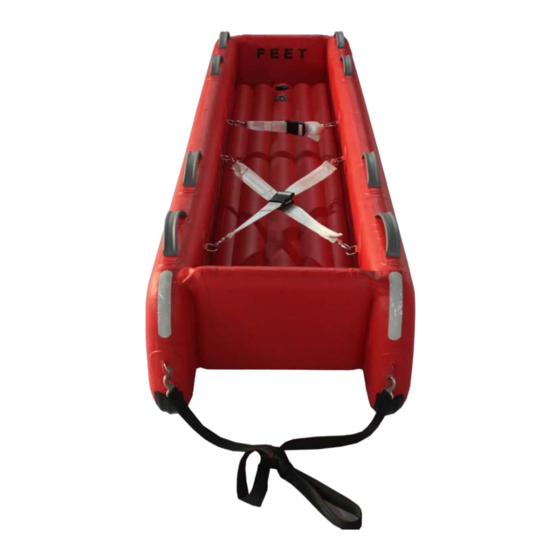
Advertisement
Quick Links
Advertisement

Summary of Contents for Saviour Medical Aquatic Sled
- Page 1 USER MANUAL...
- Page 2 Introduction The Saviour Aquatic Sled is an inflatable sled that provides a tactical evacuation device for transferring occupant(s)/casualties from within flooded houses to awaiting rescue craft, or those that require transfer to boats or a place of relative safety, either borne directly on the sled or those already in a Saviour Stretcher –...
- Page 3 Sled Features Item Description: 1: Integral fabric reinforcement for shoulders 2: Head and feet D-rings for pulling bridle(s) 3: Removable white coloured casualty retaining straps with stainless steel clips 4: Rubbing strakes under each side “sponson” 5: SOLAS reflection tape on each shoulder 6: Lifting handles 7: HR.
- Page 4 First Inflation of Sled Carefully unpack from the original box on a level floor clear of dust, debris or sharps – preferably on a ground sheet. For the first time preferably do it in indoors at ambient room temperature to allow the materials to “settle”...
- Page 5 First Inflation of Sled • Now close the valves – from open position push centre/poppet (usually yellow) inwards and rotate quarter turn in either clockwise or anti-clockwise direction, release gently to lock in the closed position. (See more information about valve operation above.) •...
- Page 6 Sled not holding pressure There may be small fluctuations due to atmospheric pressure or temperature changes – this is normal. However if large loss of pressure is detected then it is possible that the two part Halkey-Roberts valves may have become slightly slack in transit. To tighten the valve halves use the special wrench.
-
Page 7: Operational Use
Operational Use Inflation of Sled: Carefully unpack from the carry bag on a level ground clear of dust, debris or sharps – preferably on a protective ground/salvage type sheet. • Take out of bag and unravel slightly and ensure valves are open to allow air intake (but not water) •... - Page 8 Casualty Transportation Casualties can be transported either sitting or lying in the sled, or if already in a Saviour Stretcher, placed directly inside. Each occupant of a sled should wear the appropriate PPE (Personal Protective Equipment). Weight must be distributed evenly: do not move about suddenly, all movements with persons in or on the sled must be made deliberately and slowly.
-
Page 9: Inspection And Maintenance
Inspection and Maintenance Inflatable sled walls and floor The buoyancy walls and floor of the sled are manufactured from materials which require very little maintenance. Wash the sled regularly using soapy water and hose down to remove dirt etc. from the floor. Prior to washing ensure valve caps are inserted and locked in place. Stubborn marks may be cleaned using an appropriate agent and then washed down as above. -
Page 10: Technical Information
Carrying capacity – 1 person either secured in sled or in Saviour Stretcher. Max. inherent buoyancy (total volume of air chambers) 230 litres. Saviour Medical carries no responsibility for the use of this equipment. All operators should be fully trained and competent in all features and safe usage of this device.


Need help?
Do you have a question about the Aquatic Sled and is the answer not in the manual?
Questions and answers